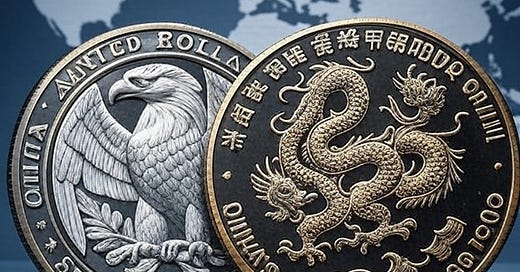China's Dollar Killer is... a Stablecoin?
Q: Will America's privatized Stablecoins beat China's central bank Stablecoins? A: The Fed has neither e-dollars nor stablecoins. The PBOC has both.
Oct. 9, 2009. PBOC Governor Zhou Xiaochuan: The world needs an international reserve currency that is disconnected from individual nations and able to remain stable in the long run, removing the inherent deficiencies caused by using credit-based national currencies [like the US dollar].
June 18, 2025. PBOC Governor Pan Gongsheng: China is facilitating a multipolar international monetary system. Not just one currency like SWIFT, but diversified cross-border payment systems. Not just the US Fed, but global coordination of financial stability and regulation.
Currency has evolved from shells to precious metals to fiat money, but it has always been both a promise from the issuer and a convenience for users, and it is for convenience that most central banks are digitizing their currencies, except for the US Federal Reserve. In keeping with its capitalist principles, the Fed is backing privately issued cryptocurrencies and Stablecoins to prolong the dollar’s exorbitant privilege1. The People’s Bank of China, PBOC, on the other hand, issued its central bank digital currency, the e-Yuan for domestic use in 2022 and has just issued an e-currency for foreign trade, a stablecoin.
What are stablecoins?
By uniting tokenised central bank reserves, commercial bank money and financial assets in the same digital venue, a unified ledger can harness tokenisation's full benefits. BIS.
Stablecoins are digital payment instruments (‘tokens’) that rely on pegged assets2 for stability. Though not true currencies, their attraction lies in their high transactional efficiency, low operational costs and fast, 24/7 cross-border payments and settlements.
Until now, all stablecoins have been privately issued and so are liable to risks like fraud, bank runs, regulatory arbitrage and cross-border jurisdictional friction. As the collapse3 of the TerraUS$ stablecoin showed, they cannot convincingly answer the question at the heart of every stablecoin: can it be redeemed reliably, at face value, at any time? They fail the three tests of any currency: singleness, elasticity and integrity. ‘Trust us’ is no substitute for the full faith and credit of central bank.
But though it seeks to preserve the dollar’s hegemony and create fresh demand for US Treasuries, the Fed refuses to issue a digital currency and instead sponsors legislation supporting privately issued, dollar-backed stablecoins.
Cui bono?
Stablecoin operators may hold more Treasury bills than even major foreign investors like China. Should money flow out of stablecoins, operators would be forced to sell Treasuries and whatever safe assets they hold, creating a positive-feedback, destabilizing-interest-rate and loss-of-confidence loop—the kind of thing that generated the 2008-2010 Great Recession and which we saw appear with frightening speed with the rapid collapse of Silicon Valley Bank. Brad DeLong.
Since the US Federal Reserve is owned by the major US banks, it is market-centric, profit-driven, decentralized, and immune to government directives–as Trump’s frustration with its Chairman, Jerome Powell, demonstrates. If the US Government issued stablecoins, they would have to be standardized, whereas privately issued stablecoins, like JPMCoin by JPMorgan, allow banks to design and manage the stablecoin’s infrastructure, rules, and use cases and tailor them to specific client needs like cross-border payments, trade finance, or internal settlement. Banks generate fees from issuing, managing and transacting with their stablecoins, creating new revenue streams. They can charge for transaction processing, custody, or integration services, which they could not do with a government CBDC. Banks can also use private stablecoins to streamline internal processes, such as interbank settlements or cross-border transfers, reducing costs and settlement times. JPMorgan’s institutional clients currently use JPMCoin for for instant payments between themselves.
Why China is wary
In 2023 Circle Corp., issuer of the second largest stablecoin, entrusted $3.3bn of its reserves to Silicon Valley Bank (SVB). When SVB collapsed, a run on Circle’s stablecoin began severing its dollar peg. Had the Fed not bailed out SVB, Circle and its stablecoin would be toast. That incident was a walk in the park given the US Treasury’s prediction that, in the climate shaped by Trump’s crypto GENIUS Act, $6.6tn of US bank deposits are in the process of migrating into stablecoins. Yanis Varoufakis.
In 2011, three years after it rescued the US from the great financial crisis, the Fed asked the PBOC to buy an outsize portfolio of Treasuries. China obliged, then watched helplessly as Quantitative Easing devalued them. Now, says central banker Kathleen Tyson, “China holds its USTs to maturity rather than sell at discount, then reinvests the proceeds in its BRI and BRICS partners”. In 2015, the US Treasury began weaponizing Treasury Bonds through sanctions and expropriations of Venezuelan, Afghani and Russian central bank reserves, alarming the PBOC (and most central banks). This year the US dollar has lost 15% of its value against global currencies. By 2025, says Ray Dalio, unsupportable borrowing will keep the economy in permanent recession4.
Enter the state-backed stablecoin
The development of stablecoins and cryptocurrencies, and their integration into global central banking systems, should be viewed as an irreversible trend. CASS Academician Li Yang.
China’s banking system is state-centric, politicized, geared for serving national policy goals, like funding the BRI and stabilizing markets, and Beijing wants the renminbi to remain free to serve domestic goal – without the competing demands that the dollar contends with when serving as an international reserve currency. That’s why it finds stablecoins so attractive.
Offshore, PBOC-backed stablecoins will broaden the yuan’s international use
Keep reading with a 7-day free trial
Subscribe to Here Comes China to keep reading this post and get 7 days of free access to the full post archives.




